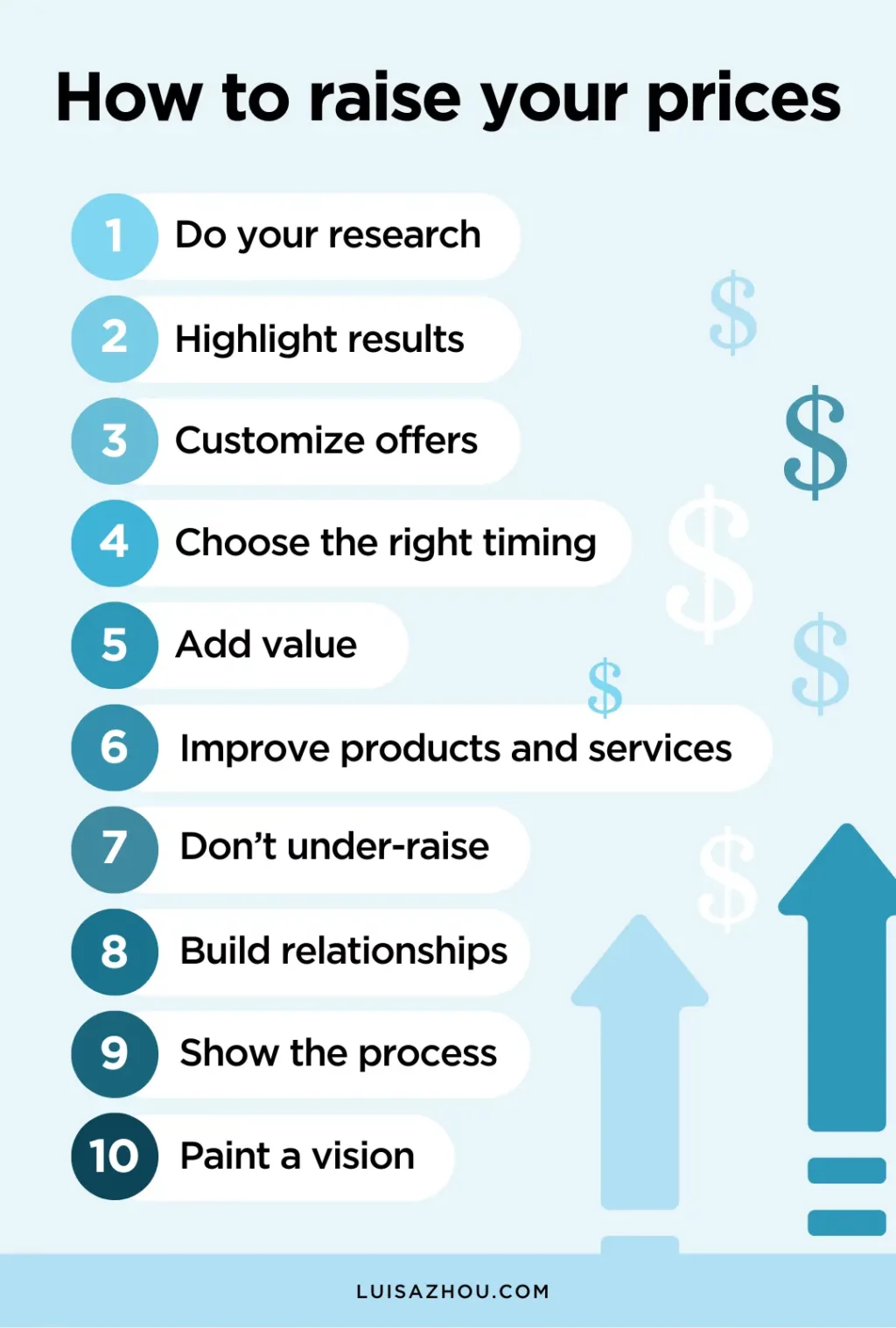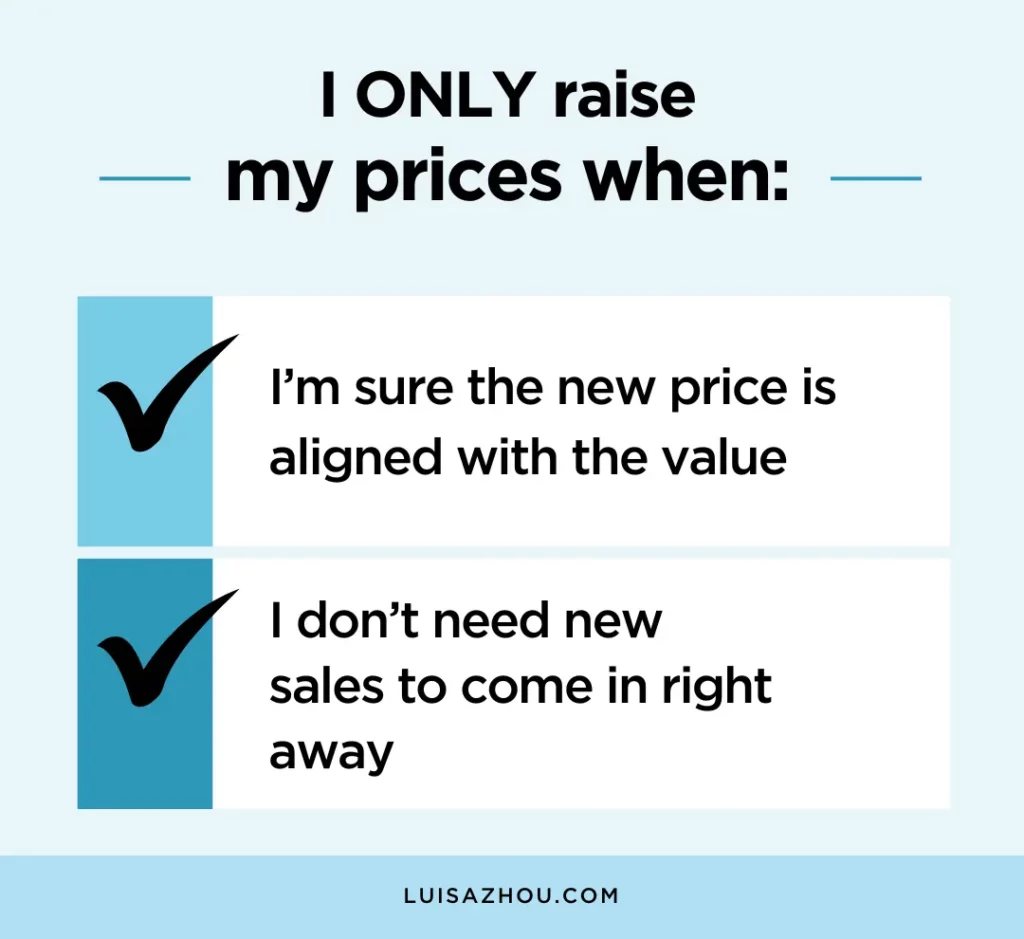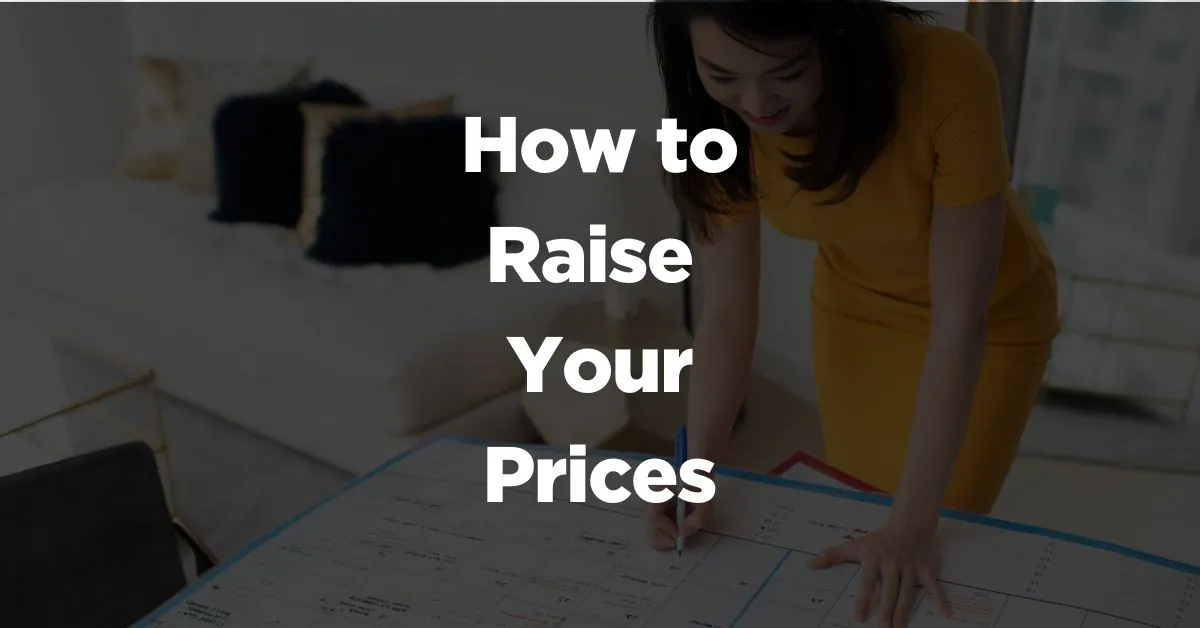Want to learn how to raise your prices?
Then you’re in the right place.
Today, I’m sharing ten tips to raise your prices.
These are steps I’ve used myself to build my business from side hustle to 8-figure business.
Ready to get started?
Let’s go!
Biggest takeaways:
- Focus on your customers – how can you increase value and make your product or service a “no brainer”?
- Time your price increase right (after a strong sales period or after you’ve added something to your offer)
- Focus on selling the transformation (not the features) so that you can ask for a higher price
Get the Ultimate Guide
for building a
6-Figure Coaching Business so you can achieve more freedom!
10 tips to raise your prices without losing customers
Price increases are sometimes necessary to maintain a profit.
However, figuring out how to raise your prices can feel overwhelming.
I’m here to tell you that it doesn’t have to be.
To raise your prices without losing clients, I recommend you:
- Do your research
- Highlight results
- Customize offers
- Choose the right timing
- Add value
- Improve products and services
- Don’t under-raise
- Build relationships
- Show the process
- Paint a vision

Let’s dive in and take a closer look at each of these steps.
1. Do your research
Before you increase your prices, carry out some market research first.
Why? So that you can make informed decisions.
As part of your research, look at what your competitors are charging so you can make sure your prices align with market expectations.
After all, you don’t want to price yourself out of the market when you raise your prices.
Market research will also help you identify areas for increasing efficiency, cutting costs, or adding new product elements.
Just don’t forget:
Your first product isn’t your final product.
For example, when I first launched my Employee to Entrepreneur self-study course, I spent years improving my course using customer feedback.
In other words:
Focus on improving your product or service so that you can increase your rates.
Action steps:
✅ Reach out to potential customers (in your network or on social media) and offer them a free coaching/consulting session in exchange for a market research call where you ask them about how they’d describe their problem and the solution they’re looking for
✅ Research your competitors online to understand what the average rates are in your industry
2. Highlight results
When considering how to raise your prices without losing clients, focus on ways to show them the value of your offer.
Remember:
People buy your why because it helps their why.

So, when pitching clients, don’t focus on the tangible things.
Instead, focus on the client’s transformation and the benefits they’ll only get by buying your offering.
When your pitch speaks directly to their aspirations and goals, it resonates far more deeply and highlights your distinct value, motivating them to use your services and buy your products.
Action steps:
✅ Think through what benefits your customers get from your product or service
✅ Include those benefits and results on your website, in your marketing copy, and in your sales calls
Customization also has this effect, which I’ll tell you about next.
Get the Ultimate Guide
for building a
6-Figure Coaching Business so you can achieve more freedom!
3. Customize offers
Your clients want personalized offers, and that changes how you sell.
You see, in my coaching business, I help people build businesses using the same foundation. (Principles that hold true no matter what someone’s industry is.)
But the pitches are all different.
When I’m on a discovery or sales call, I listen really closely and take notes about what the client tells me, including their ultimate goal, fears, and roadblocks.
Then, when it’s time to share how I can help, I tailor the process to what I’ve learned about them.
Sure, they’re getting the same overarching steps everyone else does, but it feels like a customized experience.
Not only does this feel like a better way of selling, but it also makes me a more trustworthy source, which increases client confidence and my sales.
Action steps:
✅ Research your customers to understand what they want and why
✅ Ask yourself: What parts of the sales process can you customize for your audience?
4. Choose the right timing
The key to knowing how to raise your prices?
Knowing when to do it.
I recommend raising your prices during a strong sales period or after you’ve added something new to your offering.
But at the end of the day, the right time is different for everyone.
Personally, I wait for two things to happen before I raise my prices.

First, I make sure I’m certain that the new price reflects the value of my offer.
Sometimes, I just need to tweak the program. Other times, I have to work on my beliefs to make sure I’m not undervaluing my services out of fear.
I also wait until I’m at a place where I’ll be okay if new sales don’t come in right away.
Why?
Because if sales stall as people get used to the new price, I don’t want to have to drop my price again.
I explain more here:
Action steps:
✅ Ask yourself: If you raised your prices now and lost a few sales, would your business still be OK?
✅ Review your offer: Are the results you help people get with your product/service worth a higher price?
5. Add value
Adding value is one of my favorite ways to increase my prices.
You can do this by highlighting something that sets your product apart – even if it’s mundane!
It’s called the Value Prism.
And it involves showing why your product is different from others on the market, which increases its perceived value.
Because no one can argue with the value of your product.
So when your customers feel good about the product, you can then make more sales at your new price point.

For example, take Scrub Daddy.
Founder Aaron Krause noticed how normal sponges damaged his outdoor furniture. So he tried a foam he’d invented – and it worked.
And so Scrub Daddy was born, a sponge that’s much more than a normal sponge and helps you keep your furniture clean without ruining it.
Hear more about the Value Prism and see it in action in this video:
Remember:
You’re not scamming your clients or ripping them off.
You’re simply offering a product or service that solves a problem for your clients – and you deserve to be paid for it.
Especially when you are improving your products and services, which leads me to the next point.
Action steps:
✅ Look at your product or service and ask yourself: What’s the value you’re offering?
✅ Incorporate your value proposition in your marketing material, including your social media posts, emails, and more
Get the Ultimate Guide
for building a
6-Figure Coaching Business so you can achieve more freedom!
6. Improve products and services
One of the best ways to raise your prices is to improve your offering.
If you’re a product-based business, this might mean upgrading your current product, expanding your product line, or offering limited-edition products.
But if you offer a service like coaching or consulting, you could add a highly profitable digital product like an online course.
Premium courses can sell for as much as $2,000-$3,000 per course. However, when you first start out, I recommend pricing between $197 and $497.
It’s all about choosing the right topic and teaching people to solve a problem better, faster, or cheaper.
Creating evergreen online courses is what helped me scale my business to multiple-six-figures and beyond.

These days, there’s a course for everything – I’ve rounded up nearly 200 online course ideas to get you started.
Action steps:
✅ Ask yourself: Can you upgrade your product/service somehow?
✅ Think of how you can add on products/services to your existing business.
7. Don’t under-raise out of fear
One of the most important parts of knowing how to raise your prices is being confident about it.
But it’s more than just being confident in your new price.
You have to have a steadfast belief in your ability to help people reach their goals – and in the fact that the value of the transformation is higher than their initial investment.
And that means you can’t under-raise your prices because you’re afraid of missing out on new clients.
If that’s stopping you, shift your mindset.
Instead, focus on the worth and value of your products or services.
When you do, you’ll be able to confidently ask for the price you believe truly reflects your value.
And here’s the thing: Raising your prices actually drives sales.
Why?
Because people use price to gauge a product’s quality.
In other words, the higher your price, the more valuable your product or service seems.
Hear more about why undervaluing your product actually hurts your business in the long run in this video:
Action steps:
✅ Ask yourself: What price would feel good to you?
✅ Test your price by asking for it on your next sales call or updating your pricing on your website.
8. Build relationships with customers
I hate it when I hear people tell new entrepreneurs that the client is always right, especially in the context of how to raise your prices.
Why?
Because it puts all the power into your clients’ hands and leaves you hoping they’ll buy from you.
Good selling shouldn’t be a power play – it should be a relationship.
So, think of it as sitting on the same side of the table as your client.
Instead of going back and forth, you’re working together to help your clients reach their goals.
When you do, your relationship shifts from one with a power imbalance to one of mutual respect and trust.
And that trust matters.
After all, consumers are 59% more likely to buy from a brand they trust even if it’s more expensive than competitors, and 67% more likely to stay loyal.
I’ll tell you more in this video:
Action steps:
✅ Ask yourself: Is there a way you can go from serving your client to helping them? (For example, by setting boundaries)
✅ Think through how you can communicate that to your client
9. Show the process
Look:
Your clients aren’t just buying your product or service. They’re buying you (or your brand).
That means it doesn’t really matter how different your product is.
What’s more important is how your services or products help them reach their goals.
So, show them the process!
For example, I spent hours preparing for each client’s intake call when I first started coaching.
I would create a detailed roadmap with clear instructions for getting them to their final goals.
Even though it took some extra time, that one step allowed me to ask for the price I deserved because my clients could clearly see the value of what I was offering.
So, remember:
Preparing for each client’s journey isn’t just about jotting down thoughts. It’s about paving the way for value recognition from the start.

That said, painting a vision is equally important, which we’ll look at next.
Action steps:
✅ Think through how you can show them the steps your product/service will help your clients take – and the result they’ll get
✅ Include your messaging in your marketing material and website
Get the Ultimate Guide
for building a
6-Figure Coaching Business so you can achieve more freedom!
10. Paint a vision
Storytelling is one of the most overlooked parts of knowing how to raise your prices.
It’s not enough to tell someone how you’ll help them.
You have to show them by painting a picture with your words.
Let’s say you’re a relationship coach working with someone who struggles with communication.
In that case, you would paint a vision by creating a list of actionable steps focused on those two things.
That way, you’re showing the client that it isn’t impossible to reach their goals and showing them exactly how you’ll help.
It’s also important to show what it takes to earn your knowledge when painting a vision.
Today, I help people leave their 9-5 and run profitable businesses. But it took years of building businesses and hundreds of thousands of dollars to find what works.
So, when I paint a vision for my clients, I tell them how working with me will help them avoid going through what I had to do to get here.
Now that we’ve covered how to raise your prices, let’s talk about when to do it.
Action steps:
✅ Show your audience how you help them in your copy and sales material
✅ Tie your messaging to how YOU help them achieve their goal
When should you raise prices?
There’s no right or wrong – you should raise your prices when you want to.
However, some times are better than others.
Like when you have a handful of positive testimonials or reviews under your belt.
Testimonials prove your offer resonates with clients and provides the value you promise.
Another good time to raise your prices is when you’re fully booked (or close to it) and don’t need new sales.
For example, if you’re selling a service like consulting or coaching, having ten clients is typically enough to justify raising your prices.
And if you’re an ecommerce business, you might need to raise prices to maintain your profitability in the face of inflation or increasing operational costs.
I’ll tell you what a reasonable price increase looks like next, so keep reading!
What is a reasonable price increase percentage?
Typically, a good rule of thumb for a price increase is 5% to 10% each year.
Because it’s a gradual increase, you’ll be able to keep pace with things like operating costs and inflation without losing clients.
But ultimately, it all depends on your industry and competition.
That’s where the market research we talked about earlier comes in! The right research will help you make sure your prices are in line with the rest of the market.
Want to know how to tell your customers you’ve raised your prices? I’ll share that next.
Example of how to tell customers about price increase
Knowing how to raise your prices is only part of the equation.
You also have to tell your clients.
Here’s a template you can use:
Subject: Price Adjustment
Dear [Name],
I hope you’re well.
I’m reaching out to inform you about a necessary change. Starting [date], the prices of [product/service] will slightly increase.
This decision wasn’t easy, but it will help maintain the quality you expect. Rest assured, my commitment to excellence remains unchanged.
If you have any questions, please reach out. Thank you for your understanding and continued support.
Best,
[Name]
Learn more about how to tell your customers of price increases here.
What’s next?
Knowing how to raise your prices (and when) is just one part of building a business.
Are you ready to break free of your 9-5 and launch a business that will give you more freedom and flexibility?
Then check out my FREE blueprint, which will show you the exact steps I took to grow a six-figure business and raise my prices without losing customers:

Want to Build a 6-Figure Coaching Business So You Can Achieve More Freedom?
When you sign up, you’ll also receive regular updates on building a successful online business.
Read more:
Most Effective Strategies to Increase Revenue
Most Successful Online Business Ideas
How to Run a Successful Business: Steps You MUST Take









